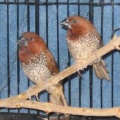
Cats
We love cats



Lonchura punctulata Learn more about the Spice "Family
Physical descriptions:
Black beak, reddish chocolate brown head, body, and wings, yellow-brown tail and rump, breast and flanks white with dark edges on the feathers in a scallop pattern, white belly and undertail. Juveniles are light brown above, paler below, and are a shade darker on the breast and flanks; they lack any markings.
Sexing:
Sexes look similar, but only the cock will sing.
Song:
The song is a series of short, rapid churrs ending in a legato whine. Songs vary considerably from male to male.
Care and Feeding: Fresh food and water must be provided daily. A good finch seed mix will provide their everyday preference for a variety of millet and grass seeds and is readily available at a pet store. In a separate cup you can offer green foods, such as lettuce, spinach, celery tops, and chickweed. Other supplements include green seeds, sprouted seeds, egg foods, and mealworms.
Distribution: Spice Finches are widely distributed throughout India, Southern Asia, Ceylon, and Malaysia.
Social Behaviors: Spice Finches are social, peaceful birds. They naturally live in groups and easily adjust to other birds in a spacious aviary.
Training: Finches are simply enjoyed for their antics and play rather than training. When you need to handle your finch to examine it or clip it's nails, place your palm on it's back and wrap your fingers around the bird with your thumb and forefinger on either side of it's head.
Temperament: They will accept a wide variety of aviaries or cages and accept a variety of nest types. Generally have a high fertility rate and raise lots of young.